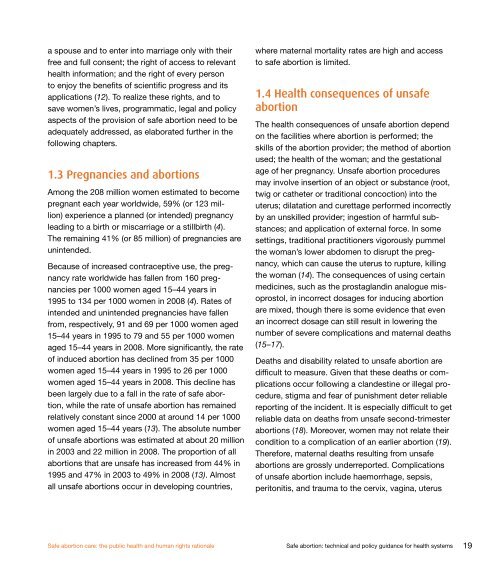Safe abortion:
Safe abortion:
Safe abortion:
You also want an ePaper? Increase the reach of your titles
YUMPU automatically turns print PDFs into web optimized ePapers that Google loves.
a spouse and to enter into marriage only with their<br />
free and full consent; the right of access to relevant<br />
health information; and the right of every person<br />
to enjoy the benefits of scientific progress and its<br />
applications (12). To realize these rights, and to<br />
save women’s lives, programmatic, legal and policy<br />
aspects of the provision of safe <strong>abortion</strong> need to be<br />
adequately addressed, as elaborated further in the<br />
following chapters.<br />
1.3 Pregnancies and <strong>abortion</strong>s<br />
Among the 208 million women estimated to become<br />
pregnant each year worldwide, 59% (or 123 million)<br />
experience a planned (or intended) pregnancy<br />
leading to a birth or miscarriage or a stillbirth (4).<br />
The remaining 41% (or 85 million) of pregnancies are<br />
unintended.<br />
Because of increased contraceptive use, the pregnancy<br />
rate worldwide has fallen from 160 pregnancies<br />
per 1000 women aged 15–44 years in<br />
1995 to 134 per 1000 women in 2008 (4). Rates of<br />
intended and unintended pregnancies have fallen<br />
from, respectively, 91 and 69 per 1000 women aged<br />
15–44 years in 1995 to 79 and 55 per 1000 women<br />
aged 15–44 years in 2008. More significantly, the rate<br />
of induced <strong>abortion</strong> has declined from 35 per 1000<br />
women aged 15–44 years in 1995 to 26 per 1000<br />
women aged 15–44 years in 2008. This decline has<br />
been largely due to a fall in the rate of safe <strong>abortion</strong>,<br />
while the rate of unsafe <strong>abortion</strong> has remained<br />
relatively constant since 2000 at around 14 per 1000<br />
women aged 15–44 years (13). The absolute number<br />
of unsafe <strong>abortion</strong>s was estimated at about 20 million<br />
in 2003 and 22 million in 2008. The proportion of all<br />
<strong>abortion</strong>s that are unsafe has increased from 44% in<br />
1995 and 47% in 2003 to 49% in 2008 (13). Almost<br />
all unsafe <strong>abortion</strong>s occur in developing countries,<br />
<strong>Safe</strong> <strong>abortion</strong> care: the public health and human rights rationale<br />
where maternal mortality rates are high and access<br />
to safe <strong>abortion</strong> is limited.<br />
1.4 Health consequences of unsafe<br />
<strong>abortion</strong><br />
The health consequences of unsafe <strong>abortion</strong> depend<br />
on the facilities where <strong>abortion</strong> is performed; the<br />
skills of the <strong>abortion</strong> provider; the method of <strong>abortion</strong><br />
used; the health of the woman; and the gestational<br />
age of her pregnancy. Unsafe <strong>abortion</strong> procedures<br />
may involve insertion of an object or substance (root,<br />
twig or catheter or traditional concoction) into the<br />
uterus; dilatation and curettage performed incorrectly<br />
by an unskilled provider; ingestion of harmful substances;<br />
and application of external force. In some<br />
settings, traditional practitioners vigorously pummel<br />
the woman’s lower abdomen to disrupt the pregnancy,<br />
which can cause the uterus to rupture, killing<br />
the woman (14). The consequences of using certain<br />
medicines, such as the prostaglandin analogue misoprostol,<br />
in incorrect dosages for inducing <strong>abortion</strong><br />
are mixed, though there is some evidence that even<br />
an incorrect dosage can still result in lowering the<br />
number of severe complications and maternal deaths<br />
(15–17).<br />
Deaths and disability related to unsafe <strong>abortion</strong> are<br />
difficult to measure. Given that these deaths or complications<br />
occur following a clandestine or illegal procedure,<br />
stigma and fear of punishment deter reliable<br />
reporting of the incident. It is especially difficult to get<br />
reliable data on deaths from unsafe second-trimester<br />
<strong>abortion</strong>s (18). Moreover, women may not relate their<br />
condition to a complication of an earlier <strong>abortion</strong> (19).<br />
Therefore, maternal deaths resulting from unsafe<br />
<strong>abortion</strong>s are grossly underreported. Complications<br />
of unsafe <strong>abortion</strong> include haemorrhage, sepsis,<br />
peritonitis, and trauma to the cervix, vagina, uterus<br />
<strong>Safe</strong> <strong>abortion</strong>: technical and policy guidance for health systems 19


